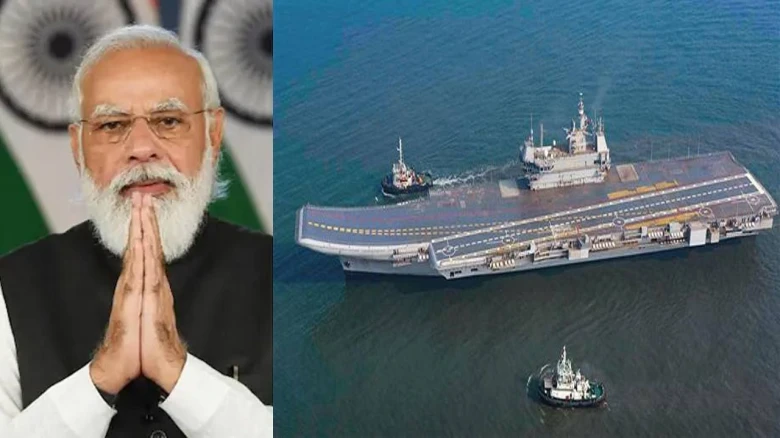Regional

Prior to the commissioning, PM Modi was greeted by a Guard of Honour at the shipyard...
Digital Desk: Prime Minister Narendra Modi commissioned the first indigenous aircraft carrier, INS Vikrant, at an event at Cochin Shipyard Limited in Kochi on Friday (September 2).
Prior to the commissioning, PM Modi was greeted by a Guard of Honour at the shipyard before proceeding to the commissioning ceremony.
The largest ship ever built in India's maritime history, Vikrant, was designed by the Indian Navy's internal Warship Design Bureau (WDB) and constructed by Cochin Shipyard Limited, a Public Sector Shipyard under the Ministry of Ports, Shipping, and Waterways.
The Indigenous Aircraft Carrier is named after her esteemed predecessor, India's first aircraft carrier, which had played a vital role in the 1971 war.
It has a large amount of indigenous equipment and machinery, with participation from big industrial enterprises as well as over 100 MSMEs. With the launch of Vikrant, India will have two operational aircraft carriers, bolstering the country's maritime security.
The 262-meter-long carrier, which is larger and more modern than her predecessor, has a full displacement of close to 45,000 tonnes, according to the Indian Navy.
Speaking about the specifications of IAC Vikrant, Vice Admiral Hampiholi said, "About 30 different planes are carried by Vikrant. The MiG 29k fighter aircraft could be used for land, air, and surface attacks. It will be able to fly the early air warning Kamov 31, the multi-role MH-60R that was recently inducted but hasn't yet been put into service, as well as our very own ALH. It is unquestionably the largest warship in the Indian Navy's inventory, with a displacement of around 45,000 tonnes."
With Vikrant, India has joined a small group of nations that have the unique capability of developing and constructing an aircraft carrier in-house. IAC Vikrant has 14 decks and 2,300 compartments. It can accommodate about 1,500 sea warriors, and its kitchen, known as the ship's galley, produces about 10,000 chapatis or rotis daily to meet food needs.
The ship has a top speed of 28 knots and is powered by four gas turbines with a combined 88 MW of power. The project, which has a total estimated cost of close to Rs 20,000 crores, has been developed throughout the course of three phases of the MoD and CSL contract, each of which was completed in May 2007, December 2014, and October 2019 respectively.
The keel of the ship was laid in February 2009, and it was launched in August 2013.
With an overall indigenous content of 76%, IAC exemplifies the nation's ambition for "Aatma Nirbhar Bharat" and gives a boost to the government's "Make in India" effort.
Vikrant was developed to support a variety of fixed-wing and rotary aircraft and features a high level of automation for ship navigation, machinery operation, and survivability.
The ship would be able to fly a 30 aircraft air wing, including MIG-29K fighter jets, Kamov-31 multi-role helicopters, MH-60R multi-role helicopters, as well as indigenously produced Advanced Light Helicopters (ALH) and Light Combat Aircraft (LCA) (Navy). The IAC is outfitted with a ski-jump for launching aircraft and a series of "arrester wires" for their recovery onboard, both of which are used in the innovative aircraft-operation mode known as STOBAR (Short Take-Off but Arrested Landing).
The ship has a significant amount of domestically produced machinery and equipment from companies including BEL, BHEL, GRSE, Keltron, Kirloskar, Larsen & Toubro, Wartsila India, and more than 100 MSMEs. Along with creating jobs and having a positive ripple impact on the economy both locally and beyond India, indigenization activities have also sparked the growth of ancillary businesses.
A significant byproduct of this is the creation and manufacture of domestic warship-grade steel for the ship through a collaboration between the Navy, DRDO, and the Steel Authority of India (SAIL), which has allowed the nation to become self-sufficient with regard to warship steel. According to the Navy, all warships currently being constructed in the nation are made of domestic steel.
The Directorate of Naval Design used a number of design iterations, including the use of 3D Virtual Reality models and sophisticated engineering tools, to create the carrier's design. During the construction of the ship, CSL also modernized its shipbuilding infrastructure and improved production techniques.
Leave A Comment